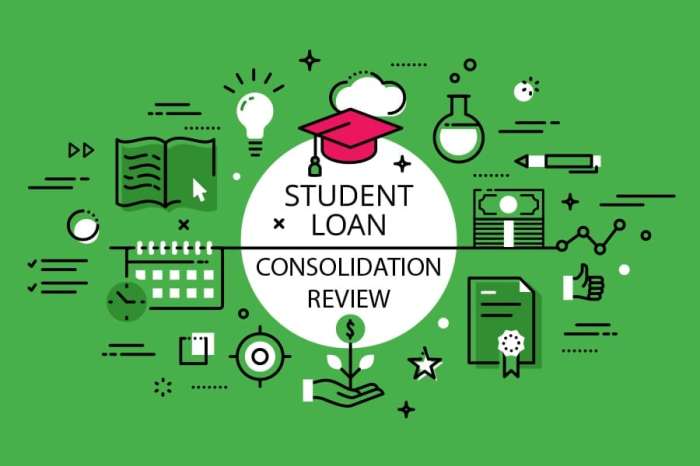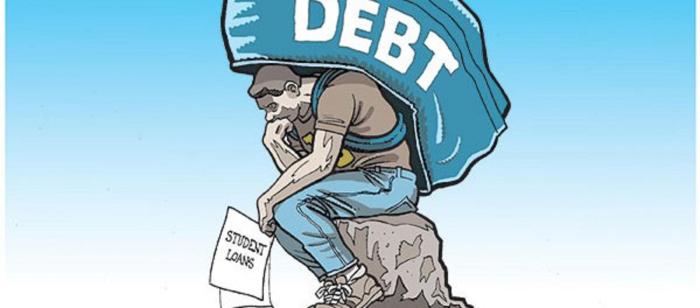
Navigating the complexities of student loan debt can feel overwhelming, but understanding the Department of Education’s student loan consolidation programs offers a potential pathway to simplification. This process allows borrowers to combine multiple federal student loans into a single, manageable loan, potentially leading to a simplified repayment process and potentially lower monthly payments. However, it’s crucial to carefully weigh the potential benefits against potential drawbacks before making a decision.
This guide provides a comprehensive overview of Department of Education student loan consolidation, covering eligibility requirements, application procedures, various repayment plans, and the potential long-term financial implications. We’ll examine the impact on interest rates, credit scores, and future access to financial aid, equipping you with the knowledge to make informed choices about your student loan debt.
Understanding Student Loan Consolidation for Department of Education Programs

Student loan consolidation, offered through the Department of Education, can simplify the repayment process for borrowers with multiple federal student loans. By combining multiple loans into a single loan, borrowers can potentially manage their debt more efficiently. This process, however, involves understanding the different programs available and their associated implications.
Types of Federal Student Loan Consolidation Programs
The Department of Education primarily offers one type of federal student loan consolidation program: the Direct Consolidation Loan. This program allows borrowers to combine their eligible federal student loans (Direct Loans, Federal Family Education Loans (FFEL), and Perkins Loans) into a single new Direct Consolidation Loan. There aren’t separate programs with distinct features; the Direct Consolidation Loan serves as the umbrella program for consolidating various federal student loan types.
Eligibility Requirements for Direct Consolidation Loans
To be eligible for a Direct Consolidation Loan, you must have at least one eligible federal student loan. Eligible loans include Direct Subsidized Loans, Direct Unsubsidized Loans, Direct PLUS Loans, FFEL Program loans, and Federal Perkins Loans. You must also be in good standing with your current lenders and agree to the terms and conditions of the Direct Consolidation Loan program. Specific requirements may vary depending on your loan types and repayment history.
Applying for Student Loan Consolidation
Applying for a Direct Consolidation Loan is a relatively straightforward process. The application is submitted online through the Federal Student Aid website (StudentAid.gov). The steps typically involve: 1) Gathering necessary information, including loan details (loan numbers, amounts, lenders); 2) Completing the online application; 3) Reviewing and signing the loan documents; and 4) Accepting the new loan terms. The process usually takes several weeks for the loan to be processed and disbursed.
Benefits and Drawbacks of Consolidating Federal Student Loans
Consolidating federal student loans offers several potential benefits, such as simplifying repayment by reducing the number of monthly payments and potentially lowering your monthly payment amount (depending on the repayment plan chosen). A single monthly payment can be easier to manage. However, it’s crucial to weigh the potential drawbacks. Consolidation may result in a longer repayment period, potentially leading to higher total interest paid over the life of the loan. Additionally, consolidating may lose certain benefits associated with specific loan types, such as forgiveness programs tied to public service or specific professions. Careful consideration of your individual financial situation is essential before deciding to consolidate.
Interest Rates and Repayment Plans After Consolidation

Consolidating your federal student loans through the Department of Education can simplify your repayment process by combining multiple loans into a single one. However, it’s crucial to understand the implications this has on your interest rate and available repayment plans. While consolidation offers convenience, it’s not always the most financially advantageous option, depending on your individual circumstances.
Consolidation typically results in a weighted average interest rate based on the interest rates of your existing loans. This weighted average is usually fixed, meaning it won’t change over the life of the loan. Importantly, this weighted average may be higher than the lowest interest rate among your original loans, particularly if you have loans with subsidized interest rates. Therefore, careful consideration of the new interest rate is vital before proceeding with consolidation. The length of your repayment term can also be affected; you might be given the option of a longer repayment period, potentially lowering your monthly payments but increasing the total interest paid over the life of the loan.
Weighted Average Interest Rate Calculation
The weighted average interest rate is calculated by considering the principal balance of each loan and its respective interest rate. Each loan’s principal balance is multiplied by its interest rate, and these products are summed. This sum is then divided by the total principal balance of all consolidated loans. For example, if you have two loans – one with a $10,000 balance at 5% interest and another with a $5,000 balance at 7% interest – the weighted average would be calculated as follows: (($10,000 * 0.05) + ($5,000 * 0.07)) / ($10,000 + $5,000) = 0.0567 or 5.67%. This new rate will then apply to your consolidated loan. This demonstrates that while consolidation simplifies repayment, it’s essential to analyze the impact on your overall interest payments.
Repayment Plan Options After Consolidation
After consolidating your federal student loans, you’ll have access to several repayment plans designed to fit different financial situations and budgets. Choosing the right plan is crucial for managing your debt effectively and minimizing long-term costs. Each plan offers a different balance between monthly payment affordability and total interest paid.
Comparison of Repayment Plans
The following table compares three common repayment plan options: Standard, Extended, and Income-Driven. Note that the monthly payment and total interest paid are illustrative examples and will vary greatly based on the loan amount and interest rate. These are estimations based on a hypothetical $30,000 loan with a 5.67% interest rate.
| Repayment Plan | Repayment Term (Years) | Estimated Monthly Payment | Estimated Total Interest Paid |
|---|---|---|---|
| Standard | 10 | $336 | $10,000 |
| Extended | 25 | $167 | $20,000 |
| Income-Driven (Example) | 20-25 (Variable) | $250 (Variable, based on income) | $15,000 (Variable) |
Impact of Repayment Plans on Total Loan Cost
The choice of repayment plan significantly impacts the total cost of your loan. A Standard plan, while resulting in higher monthly payments, minimizes the total interest paid by shortening the repayment term. Conversely, an Extended plan reduces monthly payments but extends the repayment period, leading to significantly higher total interest paid over the loan’s life. Income-driven repayment plans offer flexibility by adjusting payments based on income, providing affordability but potentially increasing the total interest paid compared to a Standard plan. For example, choosing the Extended plan in the table above will result in an additional $10,000 in interest paid compared to the Standard plan, even though the monthly payments are significantly lower. Income-driven plans offer a balance but the total interest paid will vary significantly based on individual income fluctuations throughout the repayment period.
Impact of Consolidation on Credit Score and Financial Aid
Consolidating your student loans can have a significant impact on both your credit score and your eligibility for future financial aid. Understanding these potential effects is crucial before making a decision. While consolidation simplifies repayment, it’s not a one-size-fits-all solution, and its impact varies depending on individual circumstances.
Consolidation’s effect on your credit score is complex. The immediate impact is often a slight dip, as a new account is opened and your average credit age decreases. However, responsible repayment of the consolidated loan can lead to a gradual improvement over time, as a single, larger payment demonstrates improved credit management. Conversely, defaulting on the consolidated loan will severely damage your credit score, potentially even more so than defaulting on multiple smaller loans. The overall effect depends on your pre-consolidation credit history and your subsequent repayment behavior.
Credit Score Changes After Consolidation
The impact on your credit score is multifaceted. A temporary decrease is common due to the opening of a new account and the averaging of your credit history. However, consistent on-time payments on the consolidated loan can lead to a positive impact over the long term, demonstrating improved creditworthiness. Conversely, late or missed payments can negatively impact your score, potentially more significantly than before consolidation. The length of your credit history also plays a role; longer histories tend to be less sensitive to the short-term effects of consolidation.
Impact of Consolidation on Future Financial Aid
Consolidation can affect your eligibility for future federal financial aid. While it doesn’t directly disqualify you, the consolidation process can alter your financial profile, potentially influencing the aid you receive. For instance, if you consolidate federal loans and later need additional federal student loans, the consolidated loan amount might affect your eligibility for new loans or grants based on need. The impact is specific to each aid program and varies from institution to institution.
Positive and Negative Impacts on Overall Financial Health
It’s essential to weigh the potential benefits and drawbacks of consolidation before proceeding.
Here’s a summary of potential positive and negative impacts:
- Positive Impacts: Simplified repayment process with a single monthly payment, potentially lower interest rates (depending on the type of consolidation and prevailing interest rates), improved credit score over time with consistent on-time payments.
- Negative Impacts: Temporary decrease in credit score, potential loss of certain loan benefits (e.g., income-driven repayment plans with specific loan types), potential impact on future financial aid eligibility, higher overall interest paid if the new interest rate isn’t significantly lower than the weighted average of the original loans.
Examples of Beneficial and Detrimental Consolidation Scenarios
Let’s consider some real-life scenarios:
- Beneficial Scenario: A borrower with multiple federal student loans at varying interest rates, some with high interest, consolidates into a Direct Consolidation Loan with a lower fixed interest rate. This simplifies payments and potentially saves money on interest over the loan’s lifetime. Consistent on-time payments help improve their credit score over time.
- Detrimental Scenario: A borrower with a mix of federal and private loans consolidates all loans into a private loan with a higher interest rate. They lose access to federal loan repayment programs and their credit score initially dips, with no long-term improvement due to the higher interest burden impacting their ability to make timely payments.
Potential Risks and Considerations Before Consolidation

Consolidating your student loans can seem appealing, offering the potential for a simplified repayment process. However, it’s crucial to carefully weigh the potential drawbacks before making a decision. Failing to fully understand the implications can lead to unforeseen financial difficulties. This section will Artikel key risks and considerations to help you make an informed choice.
While consolidation simplifies your payments by combining multiple loans into one, it’s not always the best financial strategy. Several potential downsides exist, primarily concerning interest rates and the loss of certain benefits associated with your individual loans. Understanding these potential pitfalls is vital to ensuring that consolidation aligns with your long-term financial goals.
Increased Interest Rates and Weighted Average Interest Rate
Consolidation often results in a weighted average interest rate. This means your new interest rate will be a calculation based on the interest rates of your existing loans, and this average may be higher than some of your individual loan rates. For example, if you have several loans with interest rates ranging from 4% to 7%, your consolidated loan’s interest rate might fall somewhere in between, potentially increasing your overall interest paid over the life of the loan. This increased interest can significantly impact your total repayment cost. It is essential to compare the weighted average interest rate offered through consolidation with your current interest rates before proceeding.
Loss of Borrower Benefits
Some federal student loan programs offer benefits like income-driven repayment plans or loan forgiveness programs based on your occupation. Consolidating your loans might cause you to lose eligibility for these benefits. For instance, consolidating a loan eligible for Public Service Loan Forgiveness (PSLF) into a Direct Consolidation Loan might reset your progress toward loan forgiveness. Therefore, carefully consider the potential loss of these benefits against the advantages of consolidation.
Checklist of Factors to Consider Before Consolidation
Before applying for student loan consolidation, it’s imperative to thoroughly evaluate your financial situation and understand the long-term implications. The following checklist can help guide your decision-making process:
- Compare your current interest rates to the offered consolidated interest rate. Will the weighted average increase your total interest paid?
- Assess your eligibility for income-driven repayment plans or loan forgiveness programs. Will consolidation affect your eligibility?
- Determine the length of your new repayment term. Will a longer repayment period save you money in the short term but cost you more in the long run due to accumulated interest?
- Review the terms and conditions of the consolidation program thoroughly. Understand all fees and potential penalties.
- Consider your overall financial goals and how consolidation will impact your long-term financial strategy.
Understanding Terms and Conditions
Each consolidation program has specific terms and conditions. Failing to fully understand these details before applying can lead to unexpected consequences. Thoroughly review all documentation, paying close attention to the interest rate, repayment terms, fees, and any potential penalties for late or missed payments. Contact the lender directly if you have any questions or uncertainties. Don’t hesitate to seek professional financial advice if needed.
Consolidating Private and Federal Student Loans
Combining private and federal student loans into a single loan can simplify repayment, but it also carries risks. Federal loans offer borrower protections and benefits not available with private loans. Consolidating them with private loans could result in the loss of these protections, potentially making it harder to manage your debt if financial difficulties arise. Carefully weigh the benefits of simplification against the potential loss of federal loan protections before making this decision.
Resources and Further Information for Borrowers
Navigating the world of student loan consolidation can feel overwhelming, but thankfully, numerous resources are available to help borrowers understand their options and make informed decisions. This section provides a comprehensive overview of reliable sources of information, contact details for relevant organizations, and guidance on utilizing online resources effectively. Understanding these resources is crucial for successfully managing your student loan debt.
Reliable Resources and Websites
Finding accurate and up-to-date information is paramount when dealing with student loans. Several government websites and reputable non-profit organizations offer detailed guidance and tools to assist borrowers.
- StudentAid.gov: The official website of the U.S. Department of Education’s Federal Student Aid office is the primary source for information on federal student loans, including consolidation. This website provides detailed information on eligibility requirements, different consolidation programs, and repayment plans.
- Federal Student Aid’s Contact Center: Provides phone and online chat support to answer questions and provide personalized guidance.
- National Foundation for Credit Counseling (NFCC): This non-profit organization offers free and low-cost credit counseling services, including guidance on student loan management and consolidation strategies.
- The Consumer Financial Protection Bureau (CFPB): The CFPB provides resources to help consumers understand their rights and avoid predatory lending practices related to student loans.
Contact Information for Relevant Organizations
Direct contact with relevant organizations can provide personalized assistance and address specific concerns.
- U.S. Department of Education, Federal Student Aid: Their website (StudentAid.gov) offers various contact methods, including a phone number and online contact form. They can answer questions about eligibility, application processes, and repayment plans.
- Your Loan Servicer: Once you have consolidated your loans, you will have a single loan servicer. Their contact information will be provided to you, and they will be your primary point of contact for all matters related to your consolidated loan.
Navigating the Department of Education Website
The Department of Education’s website (StudentAid.gov) can seem complex, but with a systematic approach, you can easily find the information you need. Begin by using the search bar to enter s such as “student loan consolidation,” “Direct Consolidation Loan,” or specific program names. The site’s navigation menu also offers clear pathways to information on loans, repayment, and other relevant topics. Look for sections dedicated to borrowers, and explore the FAQs (Frequently Asked Questions) sections for quick answers to common queries.
Services Offered by Student Loan Counselors and Financial Aid Advisors
Student loan counselors and financial aid advisors offer valuable services to help borrowers navigate the complexities of student loan repayment. These professionals can provide personalized guidance on consolidation strategies, explore different repayment plans, and help you create a comprehensive debt management plan tailored to your individual financial circumstances. Many colleges and universities offer free or low-cost financial aid advising services to their students and alumni. Independent financial advisors may also specialize in student loan debt management and can offer valuable insights and support.
Summary
Ultimately, the decision to consolidate federal student loans is a deeply personal one. While consolidation can streamline repayment and potentially lower monthly payments, it’s vital to thoroughly understand the potential ramifications on your interest rate, repayment terms, and long-term financial health. By carefully considering the factors discussed in this guide and seeking personalized advice from a financial advisor, you can confidently navigate the process and make the best decision for your unique financial situation. Remember to utilize the resources and contact information provided to access further assistance and guidance.
FAQ Summary
What happens to my loan forgiveness programs after consolidation?
Consolidation may affect your eligibility for certain loan forgiveness programs. It’s essential to research how consolidation impacts specific programs you may qualify for before proceeding.
Can I consolidate private student loans with federal loans?
No, the Department of Education’s consolidation programs only apply to federal student loans. Private loans must be handled separately.
How long does the consolidation process take?
The processing time varies, but it generally takes several weeks. You should receive confirmation once your application is processed.
What if I have defaulted on my student loans?
Consolidation may be an option even with defaulted loans, but it’s crucial to understand the implications and potentially required steps for rehabilitation before applying.
